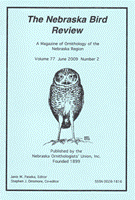Nebraska Ornithologists' Union

Nebraska Bird Review
Date of this Version
12-2015
Document Type
Article
Citation
Silcock, "Fall Field Report, August–November 2015," from Nebraska Bird Review (December 2015) 83(4).
Abstract
To start, a housekeeping item: in the species accounts that follow, whenever I use the term "migrant" I am referring to fall migration only. Many species, of course, have differing migration strategies and timing in spring and fall.
Much of the data used in this report relating to western and Pine Ridge passerines comes from the outstanding banding efforts by Bird Conservancy of the Rockies (formerly Rocky Mountains Bird Observatory) at Chadron State Park (CSP) and Wildcat Hills Nature Center (WHNC) in Scotts Bluff Co. This year’s operators were Josh Lefever and Holly Garrod. Related to the Chadron State Park station, Andrew Pierson made this interesting observation: “I was closely involved with the CSP banding station for all of the years prior to the fires (and the first year after when it was temporarily moved down to the pond area) and it was never a very successful operation. It was always way behind the Wildcat Hills site in terms of numbers and diversity. Now, it seems there are single days when they catch a former season’s worth of birds. Is this directly attributable to the fires and subsequent regeneration of new habitat type and/or quality?”
This fall and the previous two falls have been noteworthy for the large number of final sighting dates for many species that are pushing against those species’ latest expected dates. This phenomenon is across the board, both in waterbirds like Blue-winged Teal, Whooping Crane, Willet, and Common Tern, as well as passerines, such as Yellow-bellied Flycatcher (see species account for further discussion), Plumbeous Vireo, Summer Tanager, at least 5 species of sparrows, Rose-breasted Grosbeak, and Lazuli and Indigo Buntings. Conversely, a few winter visitors showed up early, such as “Oregon” and “Pink-sided” Juncos.
Surprisingly large numbers of Yellow-bellied Sapsuckers and Philadelphia Vireos appeared, as in previous fall seasons, but unexpected were influxes of Palm Warblers, usually rare in fall, and Black-throated Green Warblers.
Each season has its share of noteworthy happenings; this fall , check out the accounts for Osprey, which bred successfully for the first time in Nebraska, Black Rail, a mystery to hopefully be solved next June, a northeasterly nesting of Barn Owl, double-brooded American Kestrel, a tally of 266 Ruby-throated Hummingbirds passing through a Lincoln yard, and two very tardy Baltimore Orioles in Omaha.
Rarities this fall were few, but headed by 4th state records of both Black-headed Gull and Black-chinned Hummingbird, the latter, oddly, in far eastern Nebraska. Reports of Cave Swallow and the western subspecies of Nashville Warbler caused struggles with identification criteria, and the presence in the state of the western form of Orange-crowned Warbler was confirmed by the Pine Ridge banding stations mentioned earlier.
An update to my note in last year’s Fall Seasonal Report: at that time I mentioned that 18% of the reports I used came from eBird-only contributors. A recheck for this report shows that figure now to be 52%, obviously a significant increase in only one year. I do believe that at some point eBird will largely supersede state and local online groups like NEBirds as the repository and source for Nebraska records as long as the trend of increasing use of eBird continues. However, I believe there still is a need for analysis and comment on the data available, which is probably best done through a Seasonal Report such as this.
Finally, some of you may be wondering what my guideline is for including any given species in these accounts, as some do appear some seasons but not in others. I include ALL species that are regular in occurrence for the season at hand; no Northern Shrikes in the Summer Report, for example. I include these regular species whether reported (eBird, NEBIRDS, or personally) or not, as the absence of a regular species is noteworthy. I also include any casual or accidental species that are reported. I believe it is not noteworthy if an unexpected species does not show, so not all casual/accidental species are included in any given season. Thus a casual species such as Gyrfalcon may be reported in one Winter Report but not the next.


Comments
Copyright 2015 Nebraska Ornithologists’ Union. Used by permission.